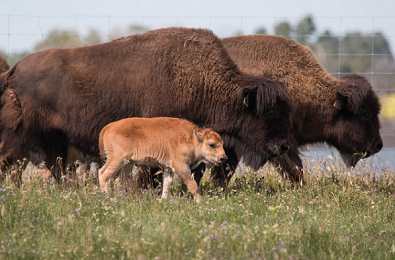One of the newborn calves. Photo by Caitlin Taylor, courtesy Flickr.
Scientists at the University of Saskatchewan have accomplished two world firsts in the area of wood bison reproduction.
This month, the veterinary researchers saw four wood bison calves born through two different methods: the first is in vitro fertilization and the second, transferring a frozen embryo to a surrogate mother. This has never been done before.
These methods were used as a way to eliminate diseases that have historically depleted the herd, so that the newborns are completely free of the disease.
They’ve been able to do this without displacing or harming any bison, said Dr. Gregg Adams, reproductive specialist at the Western College of Veterinary Medicine (WCVM).
“I’m hoping that that will ease the tensions and increase the confidence of the public and of Aboriginal communities about efforts to conserve this species,” he said.
“We can take the genetics of, say these diseased bison, from whatever herd. We can take the eggs and we can take the sperm and we can make healthy babies and we can produce healthy babies in a surrogate population and then replenish the diseased population.”
The goal is to repopulate a herd indigenous to Canada that has been decimated by two factors: disease and loss of habitat. There are only between 5,000 and 7,000 wood bison now, which is five per cent of the original population.
The diseases brucellosis and tuberculosis were first introduced to wood bison when they were mixed with cattle in the 1920s, Adams said.
These results were nine years in the making. On a personal level, seeing one of the bison calves only hours after it was born and seeing it stumble and follow its mother was a “tremendously fun, gratifying feeling” for Adams.
“We have four little tan-coloured fuzzy calves out there that don’t even look like bison. When they’re calves they just look like these little calf babies,” he said.
“It was just, a wonderful feeling to see that the babies that we were able to produce using in vitro fertilization are happy, healthy, normal calves. And of course we expected that but now we have proof.”
Right now, wood bison are mainly found in the Wood Bison National Park in Alberta.
